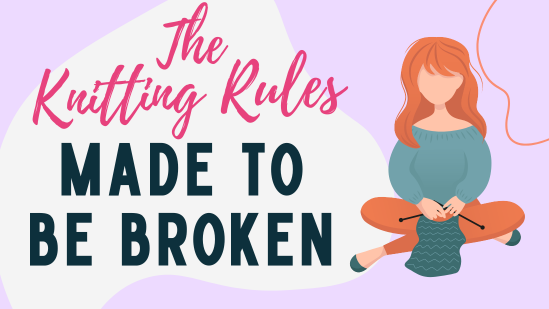When we’re first taught to knit, we are often told a few hard and fast rules that actually turn out to be more like guidelines. We’re not saying that you shouldn’t listen to what other knitters tell you, but remember that there is always an exception to the rule.
1 Use the correct needles for your yarn
The labels on yarn balls often include a tension and needle size, which is great as a suggestion but not everybody knits to the same gauge. If you’re a loose knitter, you might need a smaller needle to match the tension given in your pattern. For those of you who are dabbling at designing, you might be trying out a different effect - a bigger needle and a thinner yarn creates an easy lacy look. ‘Correct’ is actually rather subjective.
2 Always do a tension square
Theoretically yes. However, in reality it depends on the project. For garments, you should do a tension square, but for a toy it is far less important - just make sure the stuffing won’t show through and you’re golden.
3 Knot yarns together when changing colours
Some knitters like to do this and that’s perfectly ok. But you don’t have to. Just work a few stitches and the new yarn will be secure. After a couple of rows, you can safely weave in your ends.
4 Only join a new yarn at the start of a row
That’s great in theory, but if you’re working in the round, you don’t have much choice! Similarly when working with a self patterning yarn, cutting out a chunk of the colour sequence because there’s not enough to complete a full row is going to be really noticeable. Just try to make your join as inconspicuous as possible, wherever it comes.
5 Wash your knits by hand
Not everyone has time for that, so let’s pause to appreciate the marvellous invention that is superwash wool! Choose your yarn wisely and you can pop your project in with your regular wash.
6 Don’t stop in the middle of a row
If you haven’t yet learnt to read your stitches or your tension is inconsistent, this isn’t a bad practice to follow. However, if you’re working on a project that has hundreds of stitches, like a blanket or shawl, it is perfectly understable if you can’t finish your row before bedtime (or nature calls). Just make a note of which row you’re on and slide the stitches down the needle so they don’t drop off the end. When you return to your project, the yarn will be coming from your right needle.





_Craftihive_Let_s_Knit_Website_Blog_-_7.9.25_HEADER_IMAGE-01__333_180_64_c1.jpg)

_333_180_64_c1.jpg)


 Baby
Baby
 Toys
Toys
 Garments
Garments
 Crochet
Crochet
 Homewares
Homewares
 Dolls
Dolls



Share